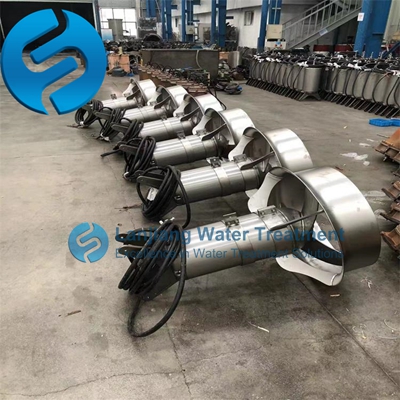Sewage mixer plays a crucial role in sewage treatment, and its role is mainly reflected in the following aspects:
First, promote the uniform distribution of suspended solids
One of the main functions of the sewage mixer is to maintain the uniform distribution of suspended solids in the sewage. Through the rotating motion of the mixer, the suspended particles and sludge in the sewage are effectively mixed to prevent their local accumulation and settlement in the water body. This uniform distribution facilitates the smooth progress of subsequent processing steps and improves the overall processing efficiency.

Second, promote microbial contact with organic matter
In biological treatment processes, such as the activated sludge process, the sewage mixer ensures effective contact between microorganisms and organic matter by promoting adequate mixing of sludge and sewage. This contact is key to the biodegradation process, which accelerates the rate of decomposition of organic matter and improves the effectiveness of biological treatment.
Third, improve sedimentation efficiency
The stirring effect of the mixer also contributes to the settlement of the sludge. In the sedimentation tank, the moderate agitation of the mixer can prevent the uneven deposition of the sludge at the bottom of the tank and form a dead zone, thus improving the sedimentation efficiency of the sludge. At the same time, stirring also helps to break the sludge floc, release the water and organic matter contained in it, and further promote the dewatering treatment of the sludge.
Fourth, prevent sludge deposition
In the water body that is still for a long time, the sludge is easy to deposit at the bottom to form a sludge layer. This not only affects the processing effect, but also may cause blockage and damage to the processing equipment. Through regular or continuous stirring, the sewage mixer can effectively prevent sludge deposition at the bottom of the pool, maintain the fluidity of the sludge, and ensure the continuity and stability of the treatment process.
Fifth, promote chemical reactions
In some chemical treatment steps, such as flocculation, precipitation, disinfection, etc., the stirring action of the mixer helps the chemicals to fully react with pollutants in the sewage. Through the stirring of the mixer, the chemicals can be quickly and evenly dispersed into the sewage, improving the reaction rate and effect.
Sixth, uniform heating or cooling
In the treatment process that needs to adjust the temperature of the sewage, the sewage mixer can also play a uniform heating or cooling role. Through the stirring of the mixer, the heat or cold amount can be evenly transferred to the sewage, avoiding the occurrence of local overheating or undercooling phenomenon, and ensuring the stability of the treatment effect.
Seventh, energy saving and maintenance reduction
Modern sewage mixers are optimized to achieve efficient mixing with low energy consumption. At the same time, the durable mixer design reduces the failure rate and reduces maintenance costs. In addition, many sewage mixers are also equipped with automated control systems, simplifying the operation process and reducing the work burden of operators.
In summary, the role of sewage mixer in sewage treatment is multi-faceted, it can not only promote the uniform distribution of suspended solids and effective contact between microorganisms and organic matter, improve sedimentation efficiency and prevent sludge deposition, but also promote the chemical reaction and uniform heating or cooling. Together, these effects improve the effectiveness and efficiency of wastewater treatment.
Post time:2024-07-14